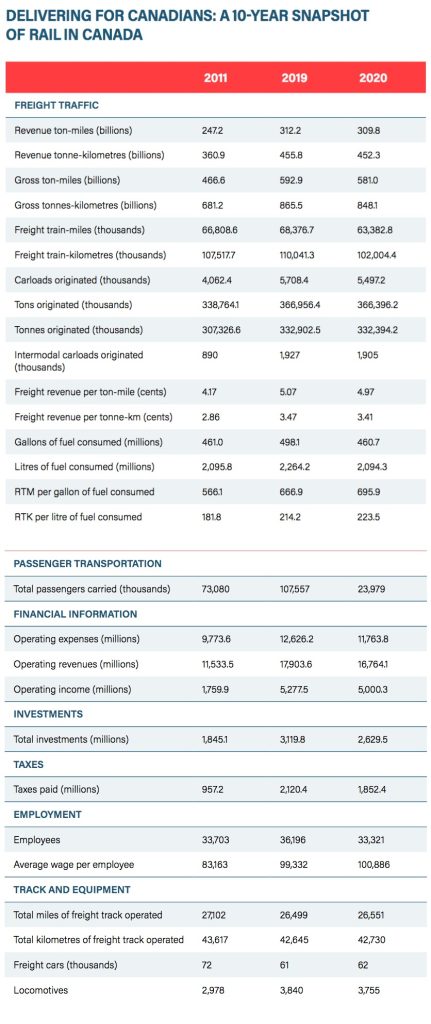
RAC Issues 10-Year Canadian Rail Snapshot
Written by Marybeth Luczak, Executive Editor
The Railway Association of Canada (RAC) has published the 29th edition of its Rail Trends report, providing a ten-year performance overview (2011-20) of its member passenger and freight railroads.
RAC members include Class I railroads (six; Kansas City Southern is not included); short lines (38); and tourist (six), intercity passenger (two) and commuter (five) railroads. CN and Canadian Pacific account for the majority of freight rail activity; data reflects performance in Canada only.
The Rail Trends report (not affiliated with the annual conference conducted in New York City by analyst Tony Hatch) covers freight transportation; fuel; passenger transportation; safety; operating finances, investments and taxes; employment; and track and equipment.

Following are among the highlights of RAC’s report (download below):
• The freight accident rate in 2020 improved by 15.1% to 1.82 accidents per billion gross ton-miles (GTM) vs. 2019; this was the second lowest rate in the past decade, RAC said. The dangerous goods accident rate improved by 35.6% to 0.17 accidents per 1,000 dangerous goods carloads, which is the lowest rate in the past 10 years.
• In 2020, the number of accidents involving passenger trains, 53, was similar to the 2015-19 average of 55. However, the accident rate increased in 2020, according to RAC, because it is based on the number of riders, which fell by 77.7% compared with 2019, and by 73.1% compared with the 2015-19 average. The association noted that passenger trains continued to operate with lower numbers of riders per train. No riders were either seriously or fatally injured in 2020, it reported.
• Freight fuel efficiency in 2020 improved by 4.3% to 696 revenue ton-miles (RTM) per gallon vs. 2019; this was the best on record, RAC said.
• In 2020, freight rail rates decreased by 1.9% to C4.97 cents per RTM vs. 2019.
• Railways invested C$2.6 billion into their Canadian assets in 2020, which is the second highest level on record, behind C$3.1 billion in 2019, RAC said. Association members also contributed C$1.9 billion in various taxes to Canadian governments.
• In 2020, freight rail traffic, measured by RTMs, decreased by 0.8% from 2019, but was 3.9% above the 2015-19 average. The freight sector’s workload, measured by GTMs, decreased by 2.0% from 2019, but was 2.9% above the 2015-19 average.
• In 2020, the number of Canadian originating carloads decreased by 3.7%, from 5.7 million in 2019 to 5.5 million. The overall weight of goods transported by RAC members decreased by 0.2% vs. 2019. As a result, RAC said, the average tonnage per carload increased by 3.7%.
• There were significant changes in carloads by commodity in 2020 compared with previous years, owing in part to the impacts of the COVID-19 pandemic, RAC reported. The largest increases in 2020 were agriculture (76,700 carloads or 14.2%) and minerals (58,800 carloads or 5.7%); the largest decreases were fuels and chemicals (-110,000 carloads or -17.0%), machinery and automotive (-54,400 carloads or -26.0%), and coal (-37,200 carloads or -10.3%).
• From 2019-20, the number of intercity railway riders fell from 5.3 million to 1.2 million (-76.9%). The ridership drop was met with a 59.4% reduction in train miles. Trains were shorter to accommodate lower ridership levels, as the reduction in passenger car miles (-67.5%) was greater than the reduction in train miles, RAC said.
• In 2020, freight railroads operated 26,551 miles of track in Canada. The industry’s freight car fleet increased by 1.2% to 61,755 cars. The number of active freight and passenger locomotives in service in decreased by 2.2% to 3,755.

• The average level of employment throughout 2020 was 2,875 employees (7.9%) lower than in 2019, according to RAC. Quarterly Class I data indicates that the most significant impacts were experienced in the second and third quarters of 2020, the association noted.
“2020 was a year like no other,” RAC President and CEO Marc Brazeau said. “While these were unprecedented times, railways from coast to coast showed resiliency by managing the volatility presented by the COVID-19 pandemic.”
DOWNLOAD THE COMPLETE REPORT HERE:



